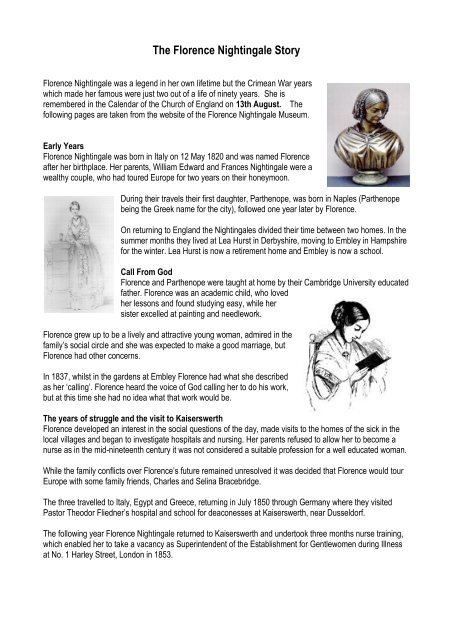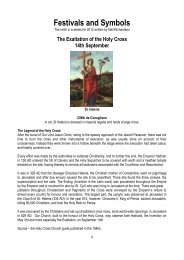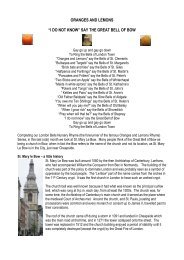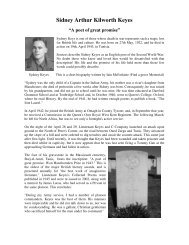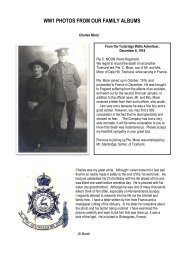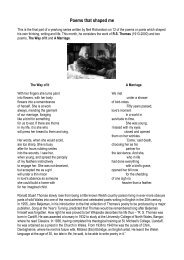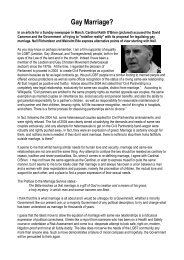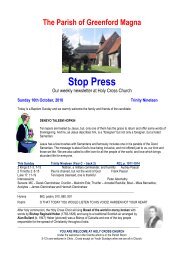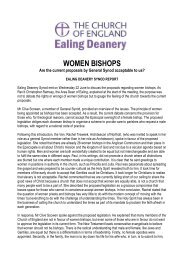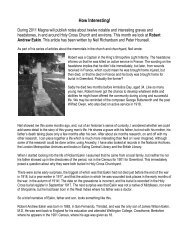The Florence Nightingale Story - The Parish of Greenford Magna
The Florence Nightingale Story - The Parish of Greenford Magna
The Florence Nightingale Story - The Parish of Greenford Magna
You also want an ePaper? Increase the reach of your titles
YUMPU automatically turns print PDFs into web optimized ePapers that Google loves.
<strong>The</strong> <strong>Florence</strong> <strong>Nightingale</strong> <strong>Story</strong><br />
<strong>Florence</strong> <strong>Nightingale</strong> was a legend in her own lifetime but the Crimean War years<br />
which made her famous were just two out <strong>of</strong> a life <strong>of</strong> ninety years. She is<br />
remembered in the Calendar <strong>of</strong> the Church <strong>of</strong> England on 13th August. <strong>The</strong><br />
following pages are taken from the website <strong>of</strong> the <strong>Florence</strong> <strong>Nightingale</strong> Museum.<br />
Early Years<br />
<strong>Florence</strong> <strong>Nightingale</strong> was born in Italy on 12 May 1820 and was named <strong>Florence</strong><br />
after her birthplace. Her parents, William Edward and Frances <strong>Nightingale</strong> were a<br />
wealthy couple, who had toured Europe for two years on their honeymoon.<br />
During their travels their first daughter, Parthenope, was born in Naples (Parthenope<br />
being the Greek name for the city), followed one year later by <strong>Florence</strong>.<br />
On returning to England the <strong>Nightingale</strong>s divided their time between two homes. In the<br />
summer months they lived at Lea Hurst in Derbyshire, moving to Embley in Hampshire<br />
for the winter. Lea Hurst is now a retirement home and Embley is now a school.<br />
Call From God<br />
<strong>Florence</strong> and Parthenope were taught at home by their Cambridge University educated<br />
father. <strong>Florence</strong> was an academic child, who loved<br />
her lessons and found studying easy, while her<br />
sister excelled at painting and needlework.<br />
<strong>Florence</strong> grew up to be a lively and attractive young woman, admired in the<br />
family’s social circle and she was expected to make a good marriage, but<br />
<strong>Florence</strong> had other concerns.<br />
In 1837, whilst in the gardens at Embley <strong>Florence</strong> had what she described<br />
as her ‘calling’. <strong>Florence</strong> heard the voice <strong>of</strong> God calling her to do his work,<br />
but at this time she had no idea what that work would be.<br />
<strong>The</strong> years <strong>of</strong> struggle and the visit to Kaiserswerth<br />
<strong>Florence</strong> developed an interest in the social questions <strong>of</strong> the day, made visits to the homes <strong>of</strong> the sick in the<br />
local villages and began to investigate hospitals and nursing. Her parents refused to allow her to become a<br />
nurse as in the mid-nineteenth century it was not considered a suitable pr<strong>of</strong>ession for a well educated woman.<br />
While the family conflicts over <strong>Florence</strong>’s future remained unresolved it was decided that <strong>Florence</strong> would tour<br />
Europe with some family friends, Charles and Selina Bracebridge.<br />
<strong>The</strong> three travelled to Italy, Egypt and Greece, returning in July 1850 through Germany where they visited<br />
Pastor <strong>The</strong>odor Fliedner’s hospital and school for deaconesses at Kaiserswerth, near Dusseldorf.<br />
<strong>The</strong> following year <strong>Florence</strong> <strong>Nightingale</strong> returned to Kaiserswerth and undertook three months nurse training,<br />
which enabled her to take a vacancy as Superintendent <strong>of</strong> the Establishment for Gentlewomen during Illness<br />
at No. 1 Harley Street, London in 1853.
<strong>The</strong> Crimean War<br />
In March 1854 Britain, France and Turkey declared war on Russia. <strong>The</strong> allies defeated the Russians at the<br />
battle <strong>of</strong> the Alma in September but reports in <strong>The</strong> Times criticised the British medical facilities for the<br />
wounded.<br />
In response, Sidney Herbert, the Minister at War, who knew <strong>Florence</strong> <strong>Nightingale</strong> socially and through her<br />
work at Harley Street, appointed her to oversee the introduction <strong>of</strong> female nurses into the military hospitals in<br />
Turkey.<br />
On 4 November 1854, <strong>Florence</strong> <strong>Nightingale</strong> arrived at the Barrack Hospital in Scutari, a<br />
suburb on the Asian side <strong>of</strong> Constantinople, with the party <strong>of</strong> 38 nurses. Initially the<br />
doctors did not want the nurses there and did not ask for their help, but within ten days<br />
fresh casualties arrived from the battle <strong>of</strong> Inkermann and the nurses were fully<br />
stretched.<br />
<strong>The</strong> ‘Lady-in-Chief’, as <strong>Florence</strong> was called, wrote home on behalf <strong>of</strong> the soldiers. She<br />
acted as a banker, sending the men’s wages home to their families, and introduced<br />
reading rooms to the hospital. In return she gained the undying respect <strong>of</strong> the British<br />
soldiers.<br />
<strong>The</strong> introduction <strong>of</strong> female nurses to the military hospitals was an outstanding success, and to show the<br />
nation’s gratitude for Miss <strong>Nightingale</strong>’s hard work a public subscription was organised in 1855.<br />
<strong>The</strong> money collected was to enable <strong>Florence</strong> <strong>Nightingale</strong> to continue her reform <strong>of</strong> nursing in the civil hospitals<br />
<strong>of</strong> Britain.<br />
War statistics<br />
British: 21, 097dead<br />
French: 100,000 dead<br />
2,755 killed in action; 10,240 killed in action;<br />
2,019 died <strong>of</strong> wounds; 20,000 died <strong>of</strong> wounds;<br />
16,323 died <strong>of</strong> disease 70,000 died <strong>of</strong> disease<br />
After the Crimean War<br />
When <strong>Florence</strong> <strong>Nightingale</strong> returned from the Crimean War in August 1856, four months after the peace treaty<br />
was signed, she hid herself away from the public’s attention.<br />
In November 1856 Miss <strong>Nightingale</strong> took a hotel room in London which became the centre for the campaign<br />
for a Royal Commission to investigate the health <strong>of</strong> the British Army. When Sidney Herbert was appointed<br />
chairman, she continued as a driving force behind the scenes.<br />
By 1860 the Royal Commission had resulted in an Army Medical School, greatly improved Army barracks and<br />
hospitals, and the best army statistics in Europe. During the decade from 1862 her main concerns were the<br />
health <strong>of</strong> the Army in India and the state <strong>of</strong> Indian public health, the development <strong>of</strong> irrigation and the system<br />
<strong>of</strong> land tenure.<br />
For her contribution to Army statistics and comparative hospital statistics in 1860 <strong>Florence</strong> <strong>Nightingale</strong> became<br />
the first woman to be elected a fellow <strong>of</strong> the Statistical Society.<br />
In 1865 she settled at 10 South Street, Mayfair, in the West End <strong>of</strong> London and apart from occasional visits to<br />
Embley, Lea Hurst and to her sister at Claydon House she lived there until her death.
<strong>Nightingale</strong> Training School for Nurses<br />
<strong>Florence</strong> <strong>Nightingale</strong>’s greatest achievement was to raise nursing to the level <strong>of</strong> a respectable pr<strong>of</strong>ession for<br />
women. In 1860, with the public subscriptions <strong>of</strong> the <strong>Nightingale</strong> Fund, she established the <strong>Nightingale</strong><br />
Training School for nurses at St Thomas’ Hospital.<br />
Mrs Sarah Wardroper, Matron at St Thomas’, became the head <strong>of</strong> the new school. <strong>The</strong> probationer nurses<br />
received a year’s training which included some lectures but was mainly practical ward work under the<br />
supervision <strong>of</strong> the ward sister. Miss <strong>Nightingale</strong>, as she was always called by the nurses, scrutinised the<br />
probationers' ward diaries and reports.<br />
From 1872 Miss <strong>Nightingale</strong> devoted closer attention to the organisation <strong>of</strong> the School and almost annually for<br />
the next thirty years she wrote an open letter to the nurses and probationers giving advice and<br />
encouragement. On completion <strong>of</strong> training Miss <strong>Nightingale</strong> gave the nurses books and invited them to tea.<br />
Once trained the nurses were sent to staff hospitals in Britain and abroad and to establish nurse training<br />
schools on the ‘<strong>Nightingale</strong> Model.’<br />
In 1860 <strong>Florence</strong> <strong>Nightingale</strong>’s best known work, Notes on Nursing, was published. It laid down the principles<br />
<strong>of</strong> nursing: careful observation and sensitivity to the patient’s needs. Notes on Nursing has been translated<br />
into eleven foreign languages and is still in print today.<br />
Public Health<br />
<strong>Florence</strong> <strong>Nightingale</strong>’s writings on hospital planning and organisation had a pr<strong>of</strong>ound effect in England and<br />
across the world. Miss <strong>Nightingale</strong> was the principal advocate <strong>of</strong> the ‘pavilion’ plan for hospitals in Britain. Like<br />
her friend, the public health reformer Edwin Chadwick, <strong>Florence</strong> <strong>Nightingale</strong> believed that infection arose<br />
spontaneously in dirty and poorly ventilated places. This mistaken belief nevertheless led to improvements in<br />
hygiene and healthier living and working environments.<br />
<strong>Florence</strong> <strong>Nightingale</strong> also advised and supported William Rathbone in the development <strong>of</strong> district nursing in<br />
Liverpool and many <strong>Nightingale</strong> trained nurses became pioneers in this field.<br />
Old Age<br />
Although <strong>Florence</strong> <strong>Nightingale</strong> was bedridden due to illness contracted in the<br />
Crimea for many years, she campaigned tirelessly to improve health<br />
standards, publishing 200 books, reports and pamphlets.<br />
In recognition <strong>of</strong> her hard work Queen Victoria awarded Miss <strong>Nightingale</strong> the<br />
Royal Red Cross in 1883. In her old age she received many honours,<br />
including the Order <strong>of</strong> Merit (1907), becoming the first woman to receive it.<br />
Her death<br />
<strong>Florence</strong> <strong>Nightingale</strong> died at home at the age <strong>of</strong> 90 on 13 August 1910 and, according to her wishes, she was<br />
buried at St Margaret’s, East Wellow, near her parent’s home, Embley Park.<br />
<strong>Florence</strong> <strong>Nightingale</strong> was more than a romantic heroine. Her farsighted reforms have influenced the nature <strong>of</strong><br />
modern health care and her writings continue to be a resource for nurses, health managers and planners.<br />
© <strong>The</strong> <strong>Florence</strong> <strong>Nightingale</strong> Museum Trust, 1999. 2, Lambeth Palace Road, London SE1 7EW


